Documents: Go to download!
User Manual
- User Manual - (English)
- Quick Guide - (English)
- User Manual - (English)
- Compatible Device - (English)

- Connections
- Remote Control and Peripherals
- Smart Features
- System and Support
- Troubleshooting
Table of contents
User manual Smart TV
Connections
Connection Guide
You can view detailed information about external devices that can be connected to the TV.
 >
>  Source > Connection Guide
Source > Connection Guide 
It shows you how to connect various external devices such as video devices, game consoles, and PCs using pictures. If you select the connection method and an external device, the connection details appear.

Connecting an Antenna
You can connect an antenna cable to your TV
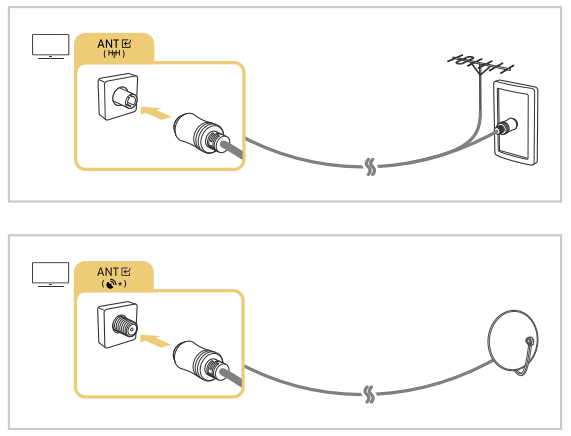
Connecting to the Internet
You can get access to the Internet through your TV.
 >
>  Settings > General > Network > Open Network Settings
Settings > General > Network > Open Network Settings 
Configure network settings to connect to an available network.
Establishing a wired Internet connection
 >
>  Settings > General Network> Open Network Settings >Wired
Settings > General Network> Open Network Settings >Wired
If you connect a LAN cable, the TV automatically accesses the Internet.

Establishing a wireless Internet connection
 >
>  Settings >General >Network > Open Network Settings > Wireless
Settings >General >Network > Open Network Settings > Wireless
Make sure that you have the wireless access point's SSID (name) and password settings before attempting to connect. The network name (SSID) and security key are available on the wireless access point's configuration screen. See the wireless access point's user manual for more information.
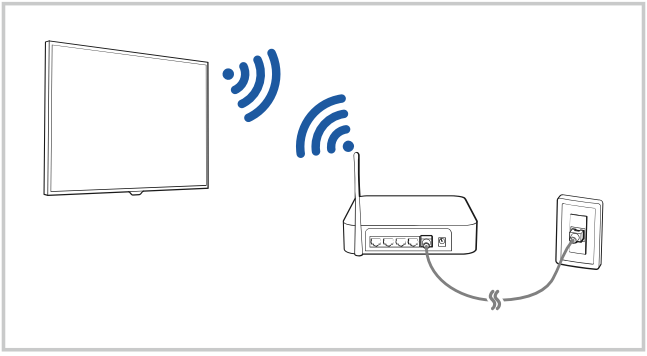
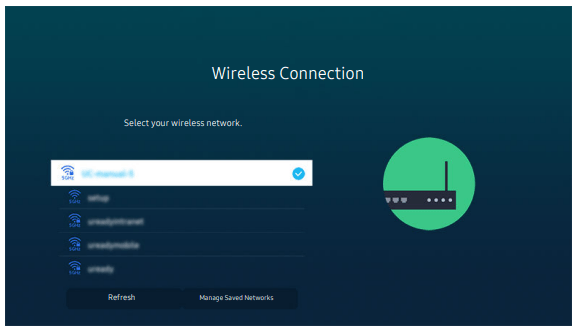
Checking the Internet connection status
 >
> Settings> General> Network > Network Status
Settings> General> Network > Network Status 
View the current network and Internet status.
Resetting Your Network
 >
> Settings > General > Network > Reset Network
Settings > General > Network > Reset Network 
Restore the network settings to the factory default.
Turning on the TV with a mobile device
 >
> Settings > General > Network > Expert Settings > Power On with Mobile
Settings > General > Network > Expert Settings > Power On with Mobile
You can turn on the TV using a mobile device connected to the same network as the TV
Connecting an IP control device to the TV
 >
>  Settings > General> Network> Expert Settings >IP Remote
Settings > General> Network> Expert Settings >IP Remote
You can connect an IP control device to the TV remotely to manage your IP device.
Allowing to connect a wireless network
 >
>  Settings >General >Network> Expert Settings >Wi-Fi
Settings >General >Network> Expert Settings >Wi-Fi
You can enable the connection to Wi-Fi.
Changing the name of the TV
 >
>  Settings > General > System Manager > Device Names
Settings > General > System Manager > Device Names 
You can change the name of the TV on the network. Select User Input at the bottom of the list and change the name.
Connection Cables for External Devices
You can view detailed information about the connection cables for external devices that can be connected to the TV.


Switching between external devices connected to the TV
You can switch between TV programs and the content of external devices.
 >
>  Source
Source
When you select a connected external device on the Source screen, the output of the selected device is displayed on the TV's screen.
Editing the name and icon of an external device
 >
>  Source
Source
You can change the port name for a connected external device or add it to the Home Screen
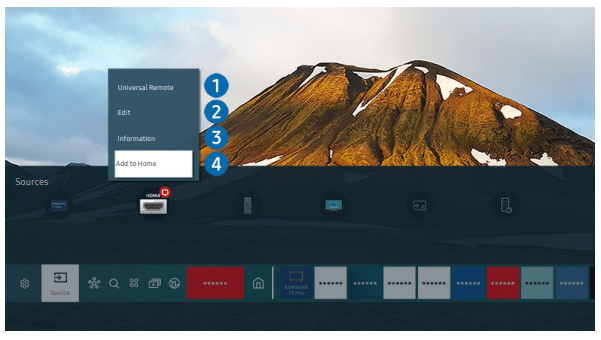
- Move the focus to a connected external device.
- Press the up directional button. The following functions become available.
 Universal Remote
Universal Remote
You can control external devices connected to the TV using a Samsung remote control. To control external devices, register them by following the instructions on the screen.
 Edit
Edit
You can rename the input ports and change the device icons.
 Information
Information
You can view detailed information about an external device.
 Add to Home
Add to Home
You can add the port of an external device to the Home Screen for quick switching.
Connection Notes
When connecting an external device, note the following.
Connection notes for HDMI
- The following types of HDMI cables are recommended:
- High Speed HDMI Cable
- High Speed HDMI Cable with Ethernet
- Premium High Speed HDMI Cable
- Premium High Speed HDMI Cable with Ethernet
- Ultra High Speed HDMI Cable
- Use an HDMI cable with a thickness of 0.66 inches (17 mm) or less.
- Using a non-certified HDMI cable may result in a blank screen or a connection error.
- Some HDMI cables and devices may not be compatible with the TV due to different HDMI specifications.
- This TV does not support HDMI Ethernet Channel. Ethernet is a Local Area Network (LAN) built with coaxial cables standardized by the IEEE.
- Use a cable shorter than 10 feet (3 m) to get the best UHD viewing quality.
- Many computer graphics adaptors do not have HDMI ports, but have DVI or DisplayPort ports instead. If your PC does not support HDMI video out, connect your PC with a DVI to HDMI or HDMI to DisplayPort cable.
- When the TV is connected to an external device such as a DVD/BD player or a set-top box via HDMI, power sync mode will be automatically activated. In the power sync mode, the TV continues to detect and connect external devices via HDMI cable. This function can be deactivated by removing the HDMI cable of the connected device.
Connection notes for audio devices
- For better audio quality, it is a good idea to use an AV receiver.
- If you connect an external audio device using an optical cable, the Sound Output setting is automatically changed to the connected device. However, to make this happen, you must turn on the external audio device before connecting the optical cable. To manually change the Sound Output setting, do one of the following:
- Use the Quick Settings screen to change to the connected device: Use the Select button to select Optical on the Sound Output menu. (
 >
> Settings up> directional button> Sound Output).
Settings up> directional button> Sound Output). - Use the Settings screen to change to the connected device: Select Optical on the Sound Output menu. (
 >
> Settings Sound> Sound Output).
Settings Sound> Sound Output).
- Use the Quick Settings screen to change to the connected device: Use the Select button to select Optical on the Sound Output menu. (
- An unusual noise coming from a connected audio device while you are using it may indicate a problem with the audio device itself. If this occurs, ask for assistance from the audio device's manufacturer.
- Digital audio is only available with 5.1 channel broadcasts.
Connection notes for computers
- For the resolutions supported by the TV, refer to "Read Before Connecting a Computer (Supported Resolutions)."
- If you want to connect your PC and TV wirelessly, both of them must be connected to each other on the same network.
- When sharing content with other network-based devices such as those in an IP (Internet Protocol) storage system, sharing may not be supported due to the network’s configuration, quality, or functionality, for example, if the network has an NAS (Network-Attached Storage) device.
Connection notes for mobile devices
- To use the Smart View function, the mobile device must support a mirroring function such as Screen Mirroring or Smart View. To check whether your mobile device supports the mirroring function, refer to the mobile device's user manual.
- To use Wi-Fi Direct, the mobile device must support the Wi-Fi Direct function. To check whether your mobile device supports Wi-Fi Direct function, refer to the mobile device's user manual.
- The mobile device and your Smart TV must be connected to each other on the same network.
- The video or audio may stop intermittently, depending on network conditions.
- When sharing content with other network-based devices such as those in an IP (Internet Protocol) storage system, sharing may not be supported due to the network’s configuration, quality, or functionality, for example, if the network has an NAS (Network-Attached Storage) device.
Remote Control and Peripherals
You can control TV operations with your Samsung Smart Remote. Pair external devices such as a keyboard for ease of use.
About the Samsung Smart Remote (QLED TV/AU9 Series or higher/The Frame)
Learn about the buttons on the Samsung Smart Remote.
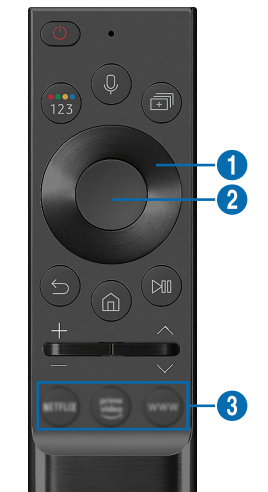

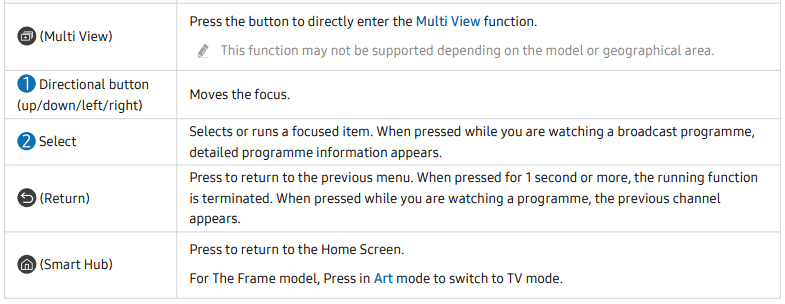

About the Samsung Smart Remote (AU8 Series)
Learn about the buttons on the Samsung Smart Remote.

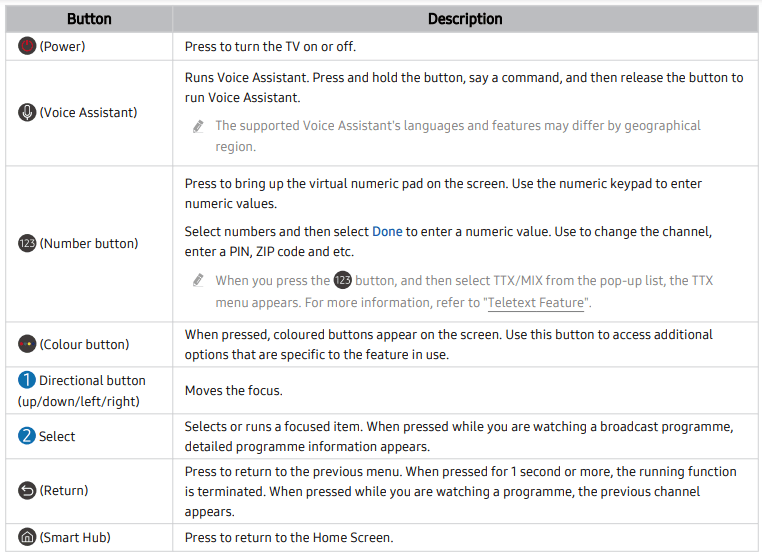
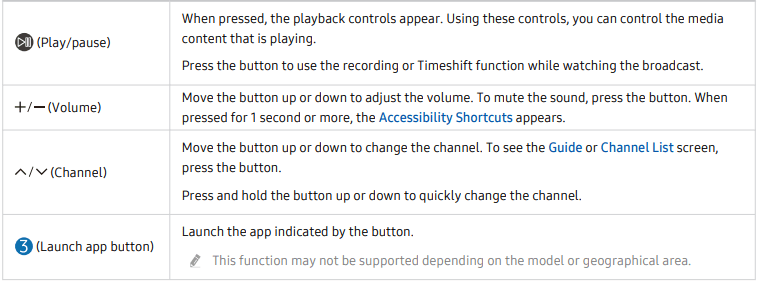
Connecting to the Samsung Smart Remote to the TV
Connect the Samsung Smart Remote to your TV to operate the TV
When you turn on the TV for the first time, the Samsung Smart Remote pairs to the TV automatically. If the Samsung Smart Remote does not pair to the TV automatically, point it at the front of the TV, then press and hold the  and
and buttons simultaneously for 3 seconds or more.
buttons simultaneously for 3 seconds or more.

Controlling External Devices with a Samsung Remote Control - Using the Universal Remote
Control the TV and connected external devices with a Samsung remote control.
 >
>  Source > Universal Remote
Source > Universal Remote
You can control external devices connected to the TV using a Samsung remote control. To control external devices, register them by following the instructions on the screen
Using Anynet+ (HDMI-CEC)
Control an external device connected via Anynet+ (HDMI-CEC) with the remote control.
You can use the TV's remote control to control external devices that are connected to the TV by an HDMI cable and that support Anynet+ (HDMI-CEC). Note that you can only set up and operate Anynet+ (HDMI-CEC) with the remote control.
Connecting an external device through Anynet+ and using their menus
 >
>  Settings > General > External Device Manager > Anynet+ (HDMI-CEC)
Settings > General > External Device Manager > Anynet+ (HDMI-CEC) 
Set Anynet+ (HDMI-CEC) to On.
Connect an HDMI-CEC-compliant device to the TV.
Turn on the connected external device.
The device is automatically connected to the TV. After the connection process is finished, you can access the menu of the connected device using your TV remote and control the device.
Read before connecting an Anynet+ (HDMI-CEC) device
Controlling the TV with a Keyboard, Mouse or Gamepad
Connecting a keyboard, mouse or gamepad to make it easier to control the TV.
 >
>  Settings > General > External Device Manager > Input Device Manager
Settings > General > External Device Manager > Input Device Manager 
You can connect a keyboard, mouse or gamepad to make it easier to control the TV.
Connecting a USB keyboard, mouse or gamepad
Plug the keyboard, mouse or gamepad cable into the USB port.
Connecting a Bluetooth keyboard, mouse, or gamepad
 >
>  Settings > General > External Device Manager >Input Device Manager> Bluetooth Device List
Settings > General > External Device Manager >Input Device Manager> Bluetooth Device List
Setting up the input devices
 >
>  Settings > General > External Device Manager > Input Device Manager
Settings > General > External Device Manager > Input Device Manager
Keyboard Settings
You can set up the keyboard with the Keyboard Language and Keyboard Type functions.
Mouse Settings
You can set up the mouse with the Primary Button and Pointer Speed functions.
Entering Text using the On-Screen Virtual Keyboard
Use the virtual keyboard to enter text on your TV
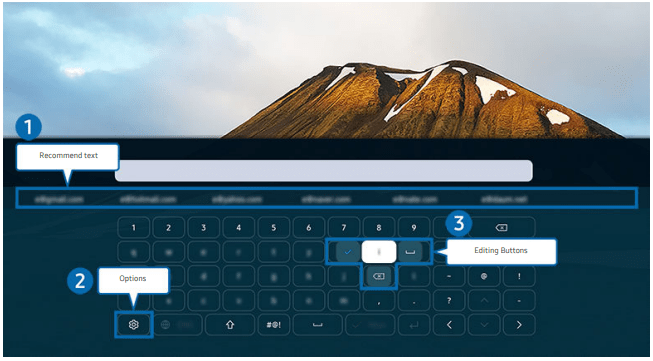
 Recommended text
Recommended text
When you type a word you want to use as a search term, this function displays related suggestions from which you can choose one.
 Options
Options
Select  on the virtual keyboard screen. The following options are available:
on the virtual keyboard screen. The following options are available:
- Recommended text
- Reset Recommended Text Memory
- Predict Next Character (when using direction buttons)
- Language
 Predict Next Character
Predict Next Character
Each time you type a character on the virtual keyboard, the next characters predicted to be typed are displayed. You can use the directional buttons on the remote control to select one
Entering Text using the remote control's microphone and the on-screen virtual keyboard
When the virtual keyboard is on the screen, press and hold the button  on the Samsung Smart Remote, speak into the microphone on the Samsung Smart Remote, and then release the button. What you say appears on the screen as text.
on the Samsung Smart Remote, speak into the microphone on the Samsung Smart Remote, and then release the button. What you say appears on the screen as text.
Smart Features
You can enjoy various apps with Smart Hub.
Using Smart Hub
View descriptions of Smart Hub's basic functions.
From Smart Hub, you can use the Internet search function, install and use various apps, view photos and videos, or listen to music stored on external storage devices, and perform more functions.
Launching Smart Hub automatically
 >
>  Settings > General > Smart Features > Autorun Smart Hub (Try Now)
Settings > General > Smart Features > Autorun Smart Hub (Try Now)
When you set Autorun Smart Hub to On, the TV displays the Home Screen automatically when you turn the TV on. You can also turn this function on or off. Press the Select button at the current menu.
Using a Samsung account
Create and manage your own Samsung account.
 >
>  Settings > General > System Manager > Samsung Account Try Now
Settings > General > System Manager > Samsung Account Try Now
Signing in to a Samsung account
 >
>  Settings > General > System Manager >Samsung Account Sign In
Settings > General > System Manager >Samsung Account Sign In
Creating a new account
 >
> Settings > General > System Manager >Samsung Account >Create Account
Settings > General > System Manager >Samsung Account >Create Account
Managing your Samsung account
 >
>  Settings > General > System Manager > Samsung Account > My Account
Settings > General > System Manager > Samsung Account > My Account
When you sign in to your Samsung account, you can use the following functions:
Sign Out
When multiple people share the TV, you can sign out of your account to prevent others from seeing it
Edit Profile
You can edit your account information.
Payment Info
You can view or manage your payment information.
Back up
You can back up the TV settings to your Samsung Cloud storage. When resetting or replacing the TV, you can also restore its settings with the backed-up settings.
TV Registration
You can register the current TV or see the registered information. You can easily receive services after product registration
Sync Internet
Once you sign in to your Samsung account and configure the Sync Internet settings, you can share the favorites and website bookmarks that you registered on other devices.
Remove Account
You can delete an account from the TV. Although you have deleted your Samsung account from the TV, you are not unsubscribed.
Terms & Conditions, Privacy Policy
You can view the user agreement and privacy policy
Using the Ambient Mode
Learn about the functions available in Ambient Mode that are specific to the QLED and SERIF TVs.
 Ambient Mode
Ambient Mode
You can enhance your living space with decorative content that matches the surroundings or view essential realtime information such as weather, time, and news on the TV screen when you are not watching TV
Ambient Mode browser screen
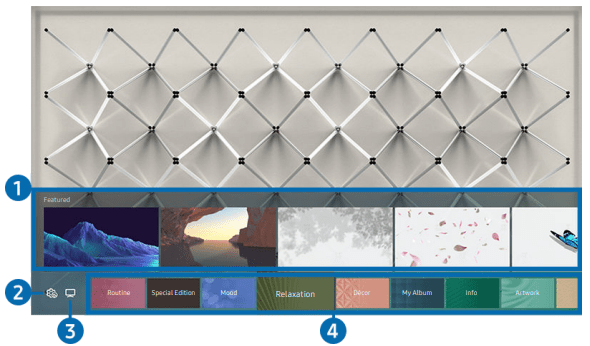
When you press the  button in Ambient Mode, the Ambient Mode browser screen appears at the bottom of the screen. In the Ambient Mode browser screen, you can select content and change the Ambient Mode settings.
button in Ambient Mode, the Ambient Mode browser screen appears at the bottom of the screen. In the Ambient Mode browser screen, you can select content and change the Ambient Mode settings.
 Function and content preview
Function and content preview
When you select a category at the bottom of the screen, a preview of available functions and content appears here.
To view detailed information about a content item, move the focus to it, and then press the up directional button.
 Ambient Settings
Ambient Settings
You can configure the following Ambient Mode settings:
Auto Brightness
Changes the auto brightness setting for Ambient Mode
Sleep After
Sets the time when the Ambient Mode screen turns off automatically.
Screen Settings
You can adjust the settings such as content brightness, saturation, and colour tone.
– Brightness
Adjusts the brightness of the content.
– Saturation
Adjusts the saturation of the content.
– Colour Tone
Adjusts the colours of the content.
– Red Tone / Green Tone / Blue Tone
Adjusts the red, green, blue contrast.
Reset All Photos
Resets the photos imported from your mobile device or Samsung Cloud.
 TV
TV
You can enter the TV viewing screen.
 Selecting a content category
Selecting a content category
You can select your preferred content and background for the Ambient Mode screen.
Routine
Enjoy a range of routines, each displaying content to suit each part of your day or create your very own routines via the SmartThings app.
Q Collection
Provides content that is dedicated to Samsung QLED.
Special Edition
Allows you to enjoy creative artwork and interior design content created by the world's finest artists and designers.
Mood
Enjoy a range of options to create the right ambience to suit your mood.
Relaxation
Relax with a selection of calming content inspired by nature to soothe your mood.
Décor
Allows you to select content with a sensible and beautiful design.
My Album
Allows you to set a photo stored in your mobile device or Samsung Cloud as the wallpaper of the Ambient Mode screen
Cinemagraph
Provides eye-catching content by giving repetitive movement in part of a photo.
Info
Allows you to select essential real-time information, such as weather, temperature, time and news.
Artwork
Allows you to select content such as world famous photos and artwork.
Background Theme
Allows you to select a background theme provided by Samsung
About Ambient Mode
You can view information about Ambient Mode.
Using the APPS Service
Download and run various apps from Smart Hub.
 >
>  APPS
APPS
You can enjoy a wide range of content including news, sports, weather, and games by installing the corresponding apps on your TV.
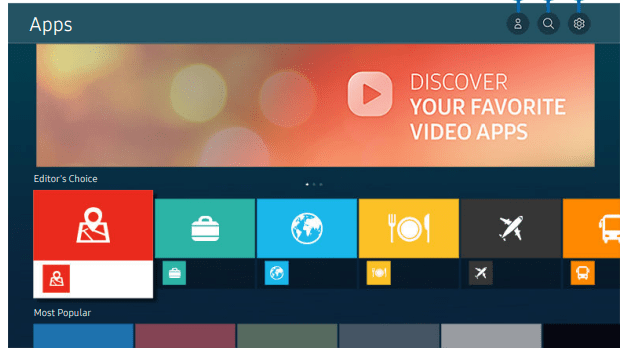
 Samsung Account
Samsung Account
Go to the Samsung Account screen to create a new account or sign out of your account.
 App Search
App Search
You can search for available apps.
 Settings
Settings
You can manage the installed apps.
Installing an app
- Move to the app you want to install, and then press the Select button. The detailed information screen appears.
- Select Install. When the installation is complete, the Open menu appears.
- Select Open to run the app immediately
Launching an app
You can run the app desired from Downloaded App.
The icons below appear within the selected app's icon and indicate the following:
 The app is installed on a USB device.
The app is installed on a USB device. The app has a password.
The app has a password. The app needs to be updated.
The app needs to be updated. The app supports the mirroring function.
The app supports the mirroring function.
Managing installed apps
Select  Settings on APPS. You can manage installed apps.
Settings on APPS. You can manage installed apps.
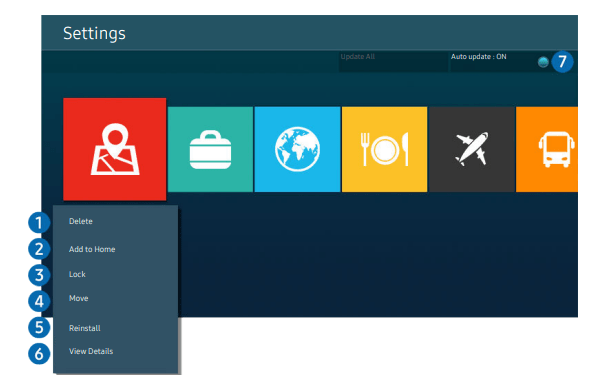
 Removing an app
Removing an app
- Select an app to delete.
- Select Delete.
The selected app is deleted.
 Adding apps to the Home Screen
Adding apps to the Home Screen
- Select an app to add.
- Select Add to Home.
- After the Home screen appears, move the selected app to the desired location.
- Press the Select button.
The selected app is added to the Home Screen.
 Locking and unlocking apps
Locking and unlocking apps
- Select an app to lock or unlock.
- Select Lock/Unlock.
The selected app is locked or unlocked
 Moving apps
Moving apps
- Select an app to move.
- Select Move.
- Move the app to the desired location.
- Press the Select button.
The selected app is moved
 Reinstalling an app
Reinstalling an app
- Select the app to install again.
- Select Reinstall.
Reinstallation starts.
 Checking the app information details
Checking the app information details
- Select the app to check.
- Select View Details.
The app information screen appears
 Automatically updating apps
Automatically updating apps
To automatically update the installed apps, set Auto Update to ON
Using Bixby
Set Voice Assistant to Bixby. Speak into the microphone on your Samsung Smart Remote or TV to control your TV.
Starting Bixby with voice
You can immediately start a conversation with Bixby by saying "Hi, Bixby". Say "Hi, Bixby", and the Bixby icon at the bottom of the TV screen is activated in Listen mode. Continue speaking.
Starting Bixby using buttons on the Samsung Smart Remote
You can also have a conversation with Bixby using the Samsung Smart Remote buttons. Press and hold the  button on your Samsung Smart Remote, say a command, and then release the
button on your Samsung Smart Remote, say a command, and then release the  button.
button.
To view the Bixby guide, press the  button once:
button once:
- When you press the
 button, the Explore Now button appears at the bottom of the screen. Press the Select button to go to the Explore Bixby screen.
button, the Explore Now button appears at the bottom of the screen. Press the Select button to go to the Explore Bixby screen.

Learning about the Explore Bixby Screen

 My Profile
My Profile
Go to the My Profile screen to create a new account or register a voice ID. Sign in to your account with your voice, that is, your registered voice ID.
 Tutorials
Tutorials
The popup window on using Bixby appears.
 Settings
Settings
You can change the settings for using Bixby
Language
You can change Bixby's language.
Voice response
You can change or turn off Bixby's voice.
Voice Wake-up
You can set to call Bixby to respond to your voice. If Bixby does not respond to your voice, turn on the Voice Wake-up function, and then try again . ( > Explore Now >
> Explore Now >  Settings > Voice Wake-up)
Settings > Voice Wake-up)
Sound feedback
Play a sound when Bixby starts and stops listening.
Privacy
You can permit or prohibit Bixby from utilizing your personal information when you are using Bixby services.
About Bixby Voice
Displays the detailed terms and conditions.
 Recommended commands
Recommended commands
Displays recommended commands you can use to control the TV with Bixby given the current context.
If you do not want to see the recommended commands, set Voice Hint to Off. ( Settings > General > Voice > Voice Hint)
Settings > General > Voice > Voice Hint)
 All Services
All Services
You can learn the voice commands that let you use Bixby in various situations. Use the directional buttons to move to the desired command, and then press the Select button. You can operate the TV with various voice commands.
Read Before Using Bixby
- The supported voice interaction languages and features may differ depending on the geographical area.
- If the language set differs from the language of your country, some features are not available.
- Bixby is available only when the TV is connected to the Internet.
- Even if the TV is connected to the Internet, there may be no response due to a Bixby server error.
- The existing functional specifications may be changed if Bixby is updated.
- Bixby is available only on TVs that support it and come with remote controls that have a microphone.
- Symbols including "-" and special characters are not supported. Consequently, if a word or sentence contains numeric values or symbols, the function may not operate properly.
- Searched results may not provide complete results.
- You may be required to pay for some apps. Consequently, you may encounter a service application or contract.
- To change the current channel by saying channel names as voice commands, you must finish Set Up YourService Provider. If Set Up Your Service Provider is not completed, you can complete it using Reset (
 >
>  Settings > General > Reset. Try Now
Settings > General > Reset. Try Now - To use the voice text input function and the search function, you must consent to provisions allowing third parties to collect and use your voice data.
- To use the Bixby function, you must:
- Agree to Smart Hub's Terms of Use
- Agree to a guidance regarding the collection and use of personal information for the Smart Hub service.
- Consent to the collection and use of personal information for the voice interaction-based service.
Provisions for using Bixby
- The voice interaction rate differs with the volume/tone, pronunciation, and ambient sound environment (TV sound and ambient noise).
System and Support
You can configure system and support settings such as clock, timers, energy usage and software updates.
Using the Time Functions and the Timers
Set the current time and use the timer function.
 >
>  Settings > General > System Manager Time Try Now
Settings > General > System Manager Time Try Now
You can set the Clock manually or automatically. Once the Clock is set, you can view the current time on the TV anytime.
You must set the clock in the following cases:
- The power cable is disconnected and then connected.
- The Clock Mode is changed from Auto to Manual.
- The TV is not connected to the Internet.
- No broadcast signals are received.
Setting the clock automatically
 >
> Settings > General > System Manager > Time > Clock > Clock Mode > Auto
Settings > General > System Manager > Time > Clock > Clock Mode > Auto
Adjusting the clock for DST and time zone
 >
>  Settings > General > System Manager > Time > Clock
Settings > General > System Manager > Time > Clock
Selects your time zone.
GMT
Set Greenwich Mean Time (GMT).
DST
Automatically adjusts for Daylight Saving Time (DST).
Changing the current time
 >
>  Settings > General > System Manager > Time > Clock > Time Offset
Settings > General > System Manager > Time > Clock > Time Offset
Time Offset adjusts the time through a network connection.
Setting the clock manually
 >
>  Settings > General > System Manager > Time > Clock > Clock Mode >Manual
Settings > General > System Manager > Time > Clock > Clock Mode >Manual
When Clock Mode is set to Manual, you can directly enter the current time. Select the Date and Time by using the directional buttons on the remote control.
When power is cut off and then supplied, the settings for Date and Time are reset to deactivate the On Timer. When their settings are assigned again, the On Timer is activated.
Using the sleep timer
 >
>  Settings > General > System Manager > Time > Sleep Timer
Settings > General > System Manager > Time > Sleep Timer
You can use this function to automatically shut off the TV after a pre-set period of time. You can set the sleep timer for up to 180 minutes after which it will turn off the TV.
Turning off the TV using the on timer
 >
>  Settings > General > System Manager > Time > On Timer
Settings > General > System Manager > Time > On Timer
You can set On Timer to turn on the TV automatically at a specific time. On Timer is only available if the Clock has been set. It is also available when Clock Mode is set to Auto, and the network or broadcast TV tuner is connected.
Turning off the TV using the off timer
 >
>  Settings > General > System Manager > Time > Off Timer
Settings > General > System Manager > Time > Off Timer
You can set Off Timer to shut off the TV automatically at a specific time. Off Timer is only available if the Clock has been set.
Updating the TV’s Software
View your TV's software version and update it if necessary
Note
DO NOT turn off the TV's power until the update is complete. The TV will turn off and on automatically after completing the software update. Video and audio settings will be reset to their defaults after a software update.
 >
>  Settings > Support > Software Update Try Now
Settings > Support > Software Update Try Now
Updating through the Internet
 >
>  Settings > Support > Software Update U> pdate Now Try Now
Settings > Support > Software Update U> pdate Now Try Now
Updating through a USB device
 >
>  Settings > Support > Software > Update Update Now
Settings > Support > Software > Update Update Now
After downloading the update file from the Samsung website and storing it on a USB device, connect the USB device to the TV to update
Updating the TV automatically
 >
>  Settings > Support > Software Update > Auto Update Try Now
Settings > Support > Software Update > Auto Update Try Now
If the TV is connected to the Internet, you can have the TV update its software automatically while you are watching the TV. When the background update is completed, it is applied the next time the TV is turned on.
If you agree to the Smart Hub terms and conditions, Auto Update is set to On automatically. If you want this function disabled, use the Select button to turn it off.
Audio and Video Functions for the Visually or Hearing Impaired
You can configure the functions for the visually or hearing impaired.
Running the accessibility functions
 >
>  Settings > General > Accessibility Try Now
Settings > General > Accessibility Try Now
Running Accessibility Shortcuts
The Accessibility Shortcuts provide easy access to the accessibility functions. To display the Accessibility Shortcuts, press and hold the (Volume) button for 2 seconds or more. You can easily turn on or turn off the functions such as Voice Guide, Picture Off, Audio Description, Subtitle, High Contrast, Enlarge, Greyscale, Colour Inversion, Learn TV Remote, Menu Learning Screen, Multi-output Audio, Sign Language Zoom, Slow Button Repeat, Accessibility Settings, etc.
Enabling voice guides for the visually impaired
 >
>  Settings > General > Accessibility > Voice Guide Settings Try Now
Settings > General > Accessibility > Voice Guide Settings Try Now
You can activate voice guides that describe the menu options aloud to aid the visually impaired. To activate this function, set Voice Guide to On. With Voice Guide on, the TV provides voice guides for channel change, volume adjust, information on current and upcoming programmes, schedule viewing, other TV functions and various content in the Internet and in Search.
You can go to Voice Guide, and then press the Select button to turn the function on or off.
Changing the volume, speed, and pitch of the Voice Guide
You can configure the Volume, Speed, Pitch and the TV Background Volume of the voice guide.
Using Other Functions
You can view other functions.
Changing the menu language
 >
> Settings > General >System Manager >Language Try Now
Settings > General >System Manager >Language Try Now
Setting up a password
 >
>  Settings > General > System Manager > Change PIN Try Now
Settings > General > System Manager > Change PIN Try Now
The PIN input window appears. Enter a PIN. Enter it again to confirm it. The default PIN is "0000."
Selecting Usage or Retail Mode
 >
> Settings > General >System Manager >Usage Mode Try Now
Settings > General >System Manager >Usage Mode Try Now
You can set the TV for retail environments by setting Usage Mode to Retail Mode.
Setting up the Button Lock
 Settings > General > System Manager > Button Lock
Settings > General > System Manager > Button Lock
You can set the TV Controller button lock. If this function is On, you cannot use TV Controller button
Setting up the USB Lock
 Settings > General > System Manager > USB Lock
Settings > General > System Manager > USB Lock
You can block connection to any external USB device.
Managing External Devices
 >
>  Settings > General > External Device Manager > Device Connect Manager Try Now
Settings > General > External Device Manager > Device Connect Manager Try Now
When you connect external devices such as mobile devices or tablets connected to the same network as the TV so you can share content, you can view the list of allowed devices and connected devices.
Access Notification
Set whether to display a notification when an external device such as a mobile device or tablet attempts to connect to the TV.
Device List
Manage a list of external devices registered to the TV.
Using AirPlay
 >
> Settings > General > Apple AirPlay Settings
Settings > General > Apple AirPlay Settings
You can use AirPlay to view content from your iPhone, iPad, or Mac on the TV screen.
Restoring the TV to the factory settings
 >
> Settings >General >Reset Try Now
Settings >General >Reset Try Now
You can restore all TV settings (excluding the Internet and network settings) to the factory defaults.
Select Reset. The security PIN entry window appears.
Enter the security PIN, and then select Yes. All settings are then reset. The TV turns off and on again automatically and displays the Initial Setup screen.
Troubleshooting
If you have a problem with your TV, you can access various solutions while watching TV. If your problem is not addressed in the Troubleshooting section, contact the Samsung Call Center.
Picture Issues
When the TV has trouble with the picture, these steps may help resolve the problem.
Testing the picture
 >
> Settings >Support >Self Diagnosis >Start Picture Test Try Now
Settings >Support >Self Diagnosis >Start Picture Test Try Now
Before you review the list of problems and solutions below, use Start Picture Test to determine if the problem is caused by the TV. Start Picture Test displays a high definition picture you can examine for flaws or faults.
Flickering and Dimming
If your TV is flickering or dimming sporadically, you may need to disable some of the energy efficiency features.
Disable Brightness Optimisation, Brightness Reduction, Motion Lighting or Contrast Enhancer.
 >
> Settings >General >Eco Solution >Ambient Light Detection
Settings >General >Eco Solution >Ambient Light Detection
 >
>  Settings >General >Eco Solution >Power Saving Mode
Settings >General >Eco Solution >Power Saving Mode
 >
> Settings> General >Eco Solution >Motion Lighting
Settings> General >Eco Solution >Motion Lighting
 >
> Settings> General >Eco Solution > Contrast Enhancer
Settings> General >Eco Solution > Contrast Enhancer
Run Picture Test. When the tested image quality is normal, check the signal of the connected device.
 >
> Settings > Support > Device Care > Self Diagnosis > Picture Test
Settings > Support > Device Care > Self Diagnosis > Picture Test
Component Connections/Screen Color
If the color on your TV screen is not correct or the black and white colors are off, run Start Picture Test.
 >
>  Settings >Support >Self Diagnosis >Start Picture Test
Settings >Support >Self Diagnosis >Start Picture Test
If the test results indicate that the problem is not caused by the TV, do the following:When using the One Connect, confirm that its video input connectors are connected to the correct external device video output connectors.
When using the component cable, confirm that the green (Y), blue (Pb), and red (Pr) jacks are plugged into their proper connectors.
For more information about how to connect an external device, run Connection Guide.
 >
>  Source >Connection Guide
Source >Connection Guide
Screen Brightness
If the screen appears too dim, try changing the settings under Reset Picture or disabling Brightness Optimisation.
 >
> Settings >Picture >Expert Settings > Reset Picture
Settings >Picture >Expert Settings > Reset Picture
 >
> Settings > General > Power and Energy Saving > Brightness Optimisation
Settings > General > Power and Energy Saving > Brightness Optimisation
If the colors on your TV are correct but just a little too dark or bright, try adjusting the following settings first.
 >
> Settings >Picture >Expert Settings >Contrast
Settings >Picture >Expert Settings >Contrast
 >
>  Settings> Picture >Expert Settings >Brightness
Settings> Picture >Expert Settings >Brightness
 >
>  Settings >Picture >Expert Settings >Sharpness
Settings >Picture >Expert Settings >Sharpness
 >
> Settings >Picture >Expert Settings >Color
Settings >Picture >Expert Settings >Color
 >
> Settings >Picture >Expert Settings T>int (G/R)
Settings >Picture >Expert Settings T>int (G/R)
Blurring, or Juddering
If you notice blurring or juddering on the screen, use the Picture Clarity Settings function to resolve the issue.
 >
>  Settings >Picture > Expert Settings > Picture Clarity Settings
Settings >Picture > Expert Settings > Picture Clarity Settings
Unwanted Powering Off
If your TV appears to turn off by itself, try disabling some of the TV's energy efficiency functions.
See if Sleep Timer has been enabled. The Sleep Timer automatically turns the TV off after a specified period of time.
 >
>  Settings >General > System Manager >Time >Sleep Timer
Settings >General > System Manager >Time >Sleep Timer
If the Sleep Timer has not been enabled, see if Auto Power Off or Off Timer has been enabled and disable it.
 >
> Settings >General >Eco Solution >Auto Power Off
Settings >General >Eco Solution >Auto Power Off
 >
> Settings >General >System Manager> Time >Off Timer
Settings >General >System Manager> Time >Off Timer
Problems Powering On
If you are having problems powering on your TV, there are a number of things to check before calling the service department.
Confirm that the TV's power cord is connected correctly at both ends and that the remote control is operating normally.
Make sure that the antenna cable or cable TV cable is firmly connected.
If you have a cable box or satellite box, confirm that it is plugged in and turned on.
In case of a model that supports One Connect Box, check the One Invisible Connection or One Connect Cable between the TV and One Connect Box.
Unable to find a Channel
If your TV is not connected to a cable box or satellite box, run Auto Program.
 >
> Settings >Broadcasting >(Auto Tuning Settings) > Auto Tuning
Settings >Broadcasting >(Auto Tuning Settings) > Auto Tuning
When using a broadcast receiver such as set-top box and IPTV, check the connection to the TV.
 Source > Connection Guide
Source > Connection Guide
When the symptom persists, contact your service provider.
The TV image does not look as good as it did in the store.
Store displays are tuned to a digital UHD channel or HD channel.
Change the output resolution of your devices such as digital broadcast receiver, IPTV and set-top box to UHD or HD.
Be sure to use an HDMI cable to enjoy high quality videos.
 Source > Connection Guide > Video Device > HDMI
Source > Connection Guide > Video Device > HDMI
To connect the TV with your PC, make sure that your PC's graphic card supports UHD resolutions.
For more information about the supported UHD resolutions, refer to "Supported Resolutions for UHD Input Signals."
For more information about the supported 8K resolutions, refer to "Resolutions for Input Signals supported by 8K models (QN7**A series or higher)".
The picture is distorted.
The compression of video content may cause picture distortions, especially in fast moving pictures from sports programs and action movies.
If the signal reception is weak or poor, screen distortion may be visible but it is not a malfunction.
Mobile phones used close to the TV (within 3.2 ft) may cause noise on analog and digital channels.
The color is wrong or missing.
If you’re using a Component connection, make sure that the Component cables are connected to the correct jacks.
Incorrect or loose connections may cause color problems or a blank screen.
The color is poor or the picture is not bright enough.
Go to Picture and then adjust the Picture Mode, Brightness, Sharpness, and Color settings.
 >
>  Settings > Picture > Picture Mode
Settings > Picture > Picture Mode
 >
> Settings > Picture > Expert Settings > Brightness
Settings > Picture > Expert Settings > Brightness
 >
> Settings > Picture > Expert Settings > Sharpness
Settings > Picture > Expert Settings > Sharpness
 >
>  Settings > Picture > Expert Settings > Color
Settings > Picture > Expert Settings > Color
See if Power Saving Mode has been enabled.
 >
>  Settings > General > Eco Solution > Power Saving Mode
Settings > General > Eco Solution > Power Saving Mode
Try resetting the picture.
 >
>  Settings > Picture > Expert Settings > Reset Picture
Settings > Picture > Expert Settings > Reset Picture
There is a dotted line on the edge of the screen.
Change Picture Size Settings to 16:9 Standard.
 >
>  Settings > Picture > Picture Size Settings
Settings > Picture > Picture Size Settings
Change the output resolution of your external device.
The picture is black and white.
Use a composite cable when you connect AV equipment to the TV.
If you are using the composite cable, connect the video cable (Yellow) to the VIDEO (Yellow / Green) input port.
Check whether Grayscale is set to On.
 >
>  Settings > General > Accessibility> Grayscale
Settings > General > Accessibility> Grayscale
The picture won’t display in full screen.
HD channels will have black bars on either side of the screen when displaying upscaled SD (4:3) content.
Black bars will appear at the top and bottom of the screen when you watch movies that have aspect ratios different from your TV.
Adjust the picture size options on your external device or set the TV to full screen.
 >
>  Settings > Picture > Picture Size Settings > Picture Size
Settings > Picture > Picture Size Settings > Picture Size
The Subtitle function in the TV menu is deactivated.
When an external device is connected with an HDMI or Component cable, the Subtitle function is unavailable. Adjust the subtitle setting on the external device.
Subtitles appear on the TV screen.
Turn off the Subtitle function in Subtitle Settings

The HDR of the connected external device turns off.
Expand the reception range of the corresponding HDMI input signal in Input Signal Plus

The TV remains on or does not turn on automatically.
If the surrounding area is too dark or bright, the motion sensor may not work normally. The performance of the motion sensor may be affected by the installation environment (height, tilt, obstacles). If the clothes you wear or your skin colour is similar to the surrounding shading, the motion sensor may not work properly.
The TV responds to all visual changes around it (lights, displays, dogs, out-of-window changes and other occurrences). You can adjust the response level by adjusting the sensitivity of the motion detector.

TV (The Frame TV) cannot be turned off.
If your TV is The Frame model, you can turn off the TV by long-pressing the Power button. To switch from Art mode to TV mode or vice versa, short-press the Power button when the TV is on.
Sound and Noise Issues
When the TV has difficulties with sound, these steps may help resolve the problem.
Testing the sound
 >
>  Settings >Support > Self Diagnosis >Start Sound Test Try Now
Settings >Support > Self Diagnosis >Start Sound Test Try Now
If the TV plays the Start Sound Test melody without distortion, there may be a problem with an external device or the broadcast signal's strength.
How can I connect an audio device to the TV?
The connection method may differ depending on the audio device.
For more information about how to connect an audio device, run Connection Guide.
 >
>  Source > Connection Guide > Audio Device
Source > Connection Guide > Audio Device
There is no sound or the sound is too low at maximum volume.
Check the volume control of your TV, and then check the volume control of the external device (cable box or satellite box, DVD, Blu-ray, etc.) connected to your TV.
Check the cable connection between an external device and the TV, and then try cable connection again.
The picture is good but there is no sound.
Set Sound Output to TV Speaker.
 >
>  Settings > Sound > Sound Output
Settings > Sound > Sound Output
If you are using an external device, check the device’s audio output option.
For example, you may need to change your cable box’s audio option to HDMI if the box connected to your TV is using an HDMI cable.
To listen to computer sound, connect an external speaker to the computer’s audio output connector.
If your TV has a headphone jack, make sure there is nothing plugged into it.
Reboot the connected device by disconnecting and then reconnecting the device’s power cable.
With a set-top box or cable box, check the cable connection and reboot the external device. When the symptom persists, contact your service provider.
No sound is heard.
Check whether Digital Output Audio Format is set to Pass-through.
If you select the Pass-through option to use an AV receiver that does not support Dolby Digital+, no sound is output with Dolby Digital+ content.
It is recommended to set Digital Output Audio Format to Auto when the connected receiver supports only the limited audio formats.
 >
> Settings >Sound >Expert Settings >Digital Output Audio Format >Auto
Settings >Sound >Expert Settings >Digital Output Audio Format >Auto
The speakers are making an odd sound.
Run Start Sound Test.
 >
> Settings >Support >Self Diagnosis >Sound Test
Settings >Support >Self Diagnosis >Sound Test
Make sure that the audio cable is connected to the correct audio output connector on the external device.
For antenna or cable connections, check the signal information. A low signal level may cause sound distortions.
 >
> Settings >Support >Self Diagnosis >Signal Information
Settings >Support >Self Diagnosis >Signal Information
The sound is interrupted.
The sound may frequently be interrupted when a Bluetooth speaker is used. Make sure that the Bluetooth speaker and the wireless access point are on a straight line and the Bluetooth speaker is placed as close as possible to the TV.
To minimise interruptions, we recommend a wireless access point that uses a 5 GHz frequency. 5 GHz may not be available depending on the model.
When the symptom persists, it is recommended to use wired connection such as HDMI (eARC) and Optical.
Whenever a function is used on the TV or the channel is changed, the TV voices the activity.
The TV explains in voice-over the video scenes displayed on the screen.
Turn off the Voice Guide function in Voice Guide Settings.
 >
>  Settings >General >Accessibility >Voice Guide Settings >Voice Guide
Settings >General >Accessibility >Voice Guide Settings >Voice Guide
The TV audio is not being played through the AV receiver.
Check the A/V receiver's power supply and its settings.
• When connecting the optical cable between the TV and A/V receiver, make sure that the sound output is set Optical on your TV.
• In case of HDMI-eARC connection, make sure that it is connected to the eARC dedicated HDMI port on your TV. However, the eARC can be used only when the A/V receiver supports the eARC feature.
The sound is not heard clearly
Change to an appropriate sound mode.
 >
>  Settings> Sound > Sound Mode
Settings> Sound > Sound Mode
When Intelligent Mode and Adaptive Sound+ are turned on, the sound effects are automatically adjusted to the surroundings.
 >
>  Settings> General > Intelligent Mode Settings > Intelligent Mode
Settings> General > Intelligent Mode Settings > Intelligent Mode
To optimise the sound depending on the surroundings, select Adaptive Sound+.
 >
>  Settings> General > Intelligent Mode Settings > Adaptive Sound+
Settings> General > Intelligent Mode Settings > Adaptive Sound+
The volume of the external device cannot be adjusted.
Check the cable connection between the TV and the external device. When connecting an external speaker such as home theatre via HDMI, make sure it is connected to the HDMI (eARC) port on the TV. Make sure that the  >
>  Settings> General >External Device Manager >Anynet+ (HDMI-CEC) is active on your TV.
Settings> General >External Device Manager >Anynet+ (HDMI-CEC) is active on your TV.
I want to turn off and on the TV and audio device at the same time.
When you connect the Samsung Soundbar to the TV via Bluetooth, the power turns off and on together. It may not be supported depending on the Samsung Soundbar model.
When you connect an audio device that supports HDMI eARC to the HDMI (eARC) port on the TV, the power turns off and on together.
Channel and Broadcast Issues
When the TV has difficulties receiving broadcasts, these steps may help resolve the problem.
Weak or No Signal” displayed in TV mode/ cannot find channel.
Make sure that the external device is connected securely and turned on. Move to Sources to switch to other input sources.
 >
> Source >Sources
Source >Sources
When using a set-top box or cable box, check the broadcast signals or the network that is connected to the external device.
The TV is not receiving all channels.
Confirm that the coaxial cable is securely connected to the TV.
Run Reset or Auto Program.
 >
> Settings >General >Reset
Settings >General >Reset
 >
>  Settings >Broadcasting >Auto Program
Settings >Broadcasting >Auto Program
There are no captions with digital channels.
Go to Caption Settings and turn on the Caption function, and then change the Caption Mode.
 >
>  Settings >General >Accessibility> Caption Settings
Settings >General >Accessibility> Caption Settings
Some channels may not have caption data
When watching a channel on an external device such as a set-top box and cable box, turn on the subtitle function on the device. For more information, contact your service provider.
Broadcasting is deactivated.
Broadcasting is only available when Source is set to TV.
Broadcasting cannot be accessed while you watch TV using a cable box or satellite box.
Broadcasting cannot be accessed while a recording is in progress or the Timeshift function is running
External Device Connectivity Issues
When the TV has difficulties connecting to external devices such as a PC, game console, or mobile device, these steps may help resolve the problem.
The "Mode Not Supported" message appears.
Adjust the output resolution of the external device to a resolution supported by the TV
The video is OK but there is no audio.
If you are using an HDMI connection, check the audio output setting on your PC.
If you are using a DVI to HDMI cable, a separate audio cable is required.
To listen to the computer sound, connect external speakers to the audio output connection of the computer.
I want to connect to a PC and mobile device via screen mirroring.
To wirelessly connect the TV to your PC, read the instructions at PC > Screen Sharing (Wireless) in Connection Guide, and then try to connect.
 >
> Source >Connection Guide >PC >Screen Sharing (Wireless)
Source >Connection Guide >PC >Screen Sharing (Wireless)
Confirm that the TV and your PC are connected to the same wireless network.
To wirelessly connect the TV to your mobile device, read the instructions at Smartphone Screen Sharing (Smart View) in Connection Guide, and then try to connect.
 >
> Source >Connection Guide >Smartphone >Screen Sharing (Smart View)
Source >Connection Guide >Smartphone >Screen Sharing (Smart View)
If the TV has difficulties connecting to your PC or mobile device due to surrounding radio interferences, change the frequency of the wireless access band, and then try to connect.
No screen appears when connecting the TV to an external device
For more information about how to connect an external device, run Connection Guide.
 >
> Source >Connection Guide
Source >Connection Guide
Make sure that the external device is connected securely and turned on. Move to Sources to switch to other input sources.
 >
> Source >Sources
Source >Sources
Using HDMI Troubleshooting, you can check the connection to HDMI cable and external devices (takes approximately 2 minutes).
 >
> Source >Connection Guide > Video Device > HDMI Troubleshooting
Source >Connection Guide > Video Device > HDMI Troubleshooting
When using a set-top box or cable box, check the broadcast signals or the network that is connected to the external device.
I want to connect to a Bluetooth speaker.
For more information on how to connect a Bluetooth speaker, see Audio Device Bluetooth in Connection Guide.
 >
> Source >Connection Guide>Audio Device > Bluetooth
Source >Connection Guide>Audio Device > Bluetooth
The PC screen does not appear or it flickers.
When the PC screen does not appear or the PC is not recognised, check the power supply of the PC and then reconnect the HDMI cable between the PC and TV. When the symptom persists, check that the PC is in Sleep mode, and then set Input Signal Plus to On.
 >
>  Settings > General > External Device Manager > Input Signal Plus
Settings > General > External Device Manager > Input Signal Plus
When the set resolution is not matched, it may cause a blank or flickering screen. For the PC supported resolution, see 'Read Before Connecting a Computer (Supported Resolutions).'
Network Issues
When the TV has difficulties connecting to the Internet, these steps may help resolve the problem.
 >
>  Settings > Support >Self Diagnosis >Start Smart Hub Connection Test Try Now
Settings > Support >Self Diagnosis >Start Smart Hub Connection Test Try Now
If the TV has trouble with network connection or TV services, check the Smart Hub connection status
Wireless network connection failed. Unable to connect to a wireless access point.
Make sure that no items that can generate electromagnetic interferences are placed between the TV and the wireless/wired access point.
Check if the access point is turned on. If it is on, turn it off, wait 1 or 2 minutes, and then turn it on.
Enter the correct password if required.
If the wireless connection fails, connect the TV to the access point via a LAN cable.
If the TV can connect to the Internet normally via the wired connection, there might be a problem with the access point. In this case, try using a different access point.
Wired network connection failed.
Check if the LAN cable is plugged in on both ends. If it is plugged in, check if the access point is turned on. If it is on, turn it off, wait 1 or 2 minutes, and then turn it on.
Auto IP configuration failed. Unable to connect to the network.
Check if the LAN cable is plugged in on both ends. If it is plugged in, check if the access point is turned on.
If the access point is on, turn it off, wait 1 or 2 minutes, and then turn it on.
Disconnect and then reconnect the power cable of the access point, or press and hold the power button for 3 seconds.
Connected to a local network, but not to the Internet.
- Check if the Internet LAN cable is connected to the access point's external LAN port.
- Check the DNS setting in IP Settings.
-  >
>  Settings >General >Network >Network Status >IP Settings
Settings >General >Network >Network Status >IP Settings
Network setup is completed, but unable to connect to the Internet.
If the problem persists, contact your Internet service provider
Anynet+ (HDMI-CEC) Issues
When Anynet+ (HDMI-CEC) isn't working, these steps may help resolve the problem.
What is Anynet+?
You can use the TV's remote control to control external devices that support Anynet+ (HDMICEC) and that are connected to the TV via an HDMI cable. For example, if a connected external device supports Anynet+, you can have the connected device turn on or off when you turn the TV on or off.
Anynet+ does not work.
Confirm that the device is an Anynet+ device. The Anynet+ system supports Anynet+ devices only.
Check if the power cord of the Anynet+ device is properly connected.
Check the cable connections of the Anynet+ device.
Go to Anynet+ (HDMI-CEC) and see if Anynet+ (HDMI-CEC) has been set to On.
 >
>  Settings >General >External Device Manager >Anynet+ (HDMI-CEC)
Settings >General >External Device Manager >Anynet+ (HDMI-CEC)
Anynet+ may not function when some other functions are active, including Channel Search, Smart Hub, Initial Setup, etc.
If you have disconnected and then reconnected the HDMI cable, scan for devices again or turn your TV off and on.
I want to start Anynet+. I also want the connected devices to turn on when the TV is turned on.
Move the focus to the Anynet+ device at  >
> Source, press the up directional button to move to Anynet+ (HDMI-CEC), and then press the Select button.
Source, press the up directional button to move to Anynet+ (HDMI-CEC), and then press the Select button.
Check if the Anynet+ device is properly connected to the TV, and then select Anynet+ (HDMICEC) menu to see if Anynet+ (HDMI-CEC) is set to On.
 >
>  Settings >General >External Device Manager >Anynet+ (HDMI-CEC)
Settings >General >External Device Manager >Anynet+ (HDMI-CEC)
I want to exit Anynet+. I also do not want the connected devices to turn on and off when the TV is turned on or off.
Turn off the Anynet+ (HDMI-CEC) function.
 >
>  Settings >General >External Device Manager >Anynet+ (HDMI-CEC)
Settings >General >External Device Manager >Anynet+ (HDMI-CEC)
When Anynet+ (HDMI-CEC) is turned off, the sound bar connected via the HDMI (eARC) port does not turn off and on together with the TV. To prevent a specific device connected to the TV from turning off automatically, turn off the HDMI-CEC function on a specific device connected to the TV.
The message "Connecting to Anynet+ device..." or "Disconnecting from Anynet+ device" appears on the screen.
You cannot use the remote control when the TV is configuring Anynet+ or switching to the TV viewing screen.
Use the remote control after the TV has completed the Anynet+ configuration or has switched to the TV viewing screen.
The Anynet+ device won't play.
You cannot use the play function when Reset is in progress
The connected device is not displayed.
Check whether the device supports Anynet+.
Anynet+ devices must be connected to the TV using an HDMI cable. Make sure the device is connected to your TV with an HDMI cable. Some HDMI cables may not support Anynet+.
Check whether the HDMI cable is properly connected.
Go to Anynet+ (HDMI-CEC) and see if Anynet+ (HDMI-CEC) has been set to On.
 >
> Settings >General >External Device Manager >Anynet+ (HDMI-CEC)
Settings >General >External Device Manager >Anynet+ (HDMI-CEC)
Scan for Anynet+ devices again.
If the connection is terminated because there has been a power failure or the HDMI cable has been disconnected, please scan for the device again.
Remote Control Issues
When the remote control isn't working, these steps may help resolve the problem.
The remote control does not work.
The connection between the Samsung Smart Remote and the TV may be lost.
Point the Samsung Smart Remote at the front of the TV, and then press and hold the  and
and  buttons simultaneously for 3 seconds or more.
buttons simultaneously for 3 seconds or more.
Also, if the remote control is not working or slow, the batteries might be low or dead.
- Charge the remote control by using the USB port (C-type) on the bottom, or turn over the remote to expose the solar cell.
- You can check remaining battery of Samsung Smart Remote with solar cell in  Settings > General > Power and Energy Saving > Available Remote Battery.
Settings > General > Power and Energy Saving > Available Remote Battery.
If the remote control has batteries, replace them with new ones.
External devices cannot be operated with the TV remote control.
Check the cable connection between the TV and external devices. When the symptom persists, set it manually in  > Source > Universal Remote.
> Source > Universal Remote.
The remote control batteries run out quickly.
The batteries may be consumed quickly if the remote control is used very frequently or the Voice Wake-up function is turned on.
You can extend the battery life by turning off the Voice Wake-up function.
 > Explore Now >
> Explore Now >  Settings Voice Wake-up
Settings Voice Wake-up
Recording Issues
When Timeshift or Schedule recording aren't working, these steps may help resolve the problem
The Timeshift or recording function cannot be used.
Check if there is a storage device connected to the TV.
Recording will automatically stop if the signal becomes too weak.
Check the free space on the storage device.
The function will not work if there isn't enough storage space on the USB device.
Before using the recording function, be sure to read all precautions. For more information, refer to "Before Using the Recording and Timeshift Functions."
Cannot record videos received from an external device or Samsung TV Plus.
The recording function is only available for digital broadcast channels received by the TV.
You cannot record videos received from an external device or Samsung TV Plus.
The "Format Device" message appears when the Timeshift or recording function is used.
To use the recording function, the storage device connected to the TV must have been already formatted.
Formatting the storage device deletes all data from it, and the storage device is formatted in NTFS.
The recorded files on the TV are not played back on a PC.
The recorded files on the TV can only be played back on the same TV. Those video files cannot be played back on a PC or other TV.
Apps
When apps aren't working, these steps may help resolve the problem.
I launched an app, but it's in English. How can I change the language?
Languages supported by an app may be different from the TV Language set in the menu.
The ability to change the language depends on the app's provider.
The app does not work properly. Its image quality is poor.
Check the network connection. When the network speed is slow, the app may not work or its image quality may be poor.
The services of your application are not provided by the TV but by the application service provider.
Refer to the Help section on the application service provider's website.
The Smart Hub home screen keeps appearing whenever you turn on the TV.
Turn off the Autorun Smart Hub function in Smart Features.
 Settings > General > Smart Features > Autorun Smart Hub
Settings > General > Smart Features > Autorun Smart Hub
Media Files
When files don't play, this may help resolve the problem.
Some files are interrupted during playback.
This problem may occur with unsupported files or high-bitrate files. Most files can be played back, but some files may not play smoothly.
Some files can't be played.
Some files that use an unsupported codec may not be played back.
Make sure that the codec is supported by the TV. For more information about the supported codecs, refer to "Read Before Playing Photo, Video, or Music Files."
Voice Recognition Issues
When the voice recognition or Bixby functions aren't working, these steps may help resolve the problem.
The voice commands do not work well.
Voice commands may differ depending on the Voice Assistant.
Refer to the command examples for each Voice Assistant.

Bixby or Alexa answers automatically.
The TV may recognise an ambient noise or everyday conversation as a call to Voice Assistant.
Turn off the Voice Wake-up function or set the Wake-up Sensitivity to Low.
 >Explore Now >
>Explore Now >  Settings >Voice Wake-up
Settings >Voice Wake-up
I spoke "Hi, Bixby" but Bixby does not answer.
I spoke "Alexa" but Amazon Alexa does not answer.
When the TV is far from you or the ambient noise is so loud, the TV may be unable to recognise your voice.
• When the distance to the TV is within 3 to 4 m, optimal performance is provided. Please look at your TV screen and speak.
Turn on the Voice Wake-up function
 >Explore Now >
>Explore Now >  Settings >Voice Wake-up
Settings >Voice Wake-up
Voice recognition does not work with the Samsung Smart Remote unlike other features.
There is no response even if the Voice Assistant button is pressed.
The connection between the remote control and the TV may be lost. Try pairing the remote control with the TV.
Point the Samsung Smart Remote at the front of the TV, and then press and hold the  and
and  buttons simultaneously for 3 seconds or more.
buttons simultaneously for 3 seconds or more.
Also, if the remote control does not work properly or its response is very slow, the battery might be low or dead.
• Charge the remote control by using the USB port (C-type) on the bottom, or turn over the remote to expose the solar cell.
– You can check remaining battery of Samsung Smart Remote with solar cell in  Settings > General > Power and Energy Saving > Available Remote Battery.
Settings > General > Power and Energy Saving > Available Remote Battery.
• If the remote control has batteries, replace them with new ones.
During voice recognition, the heavy load message appears and the function does not work.
Unplug and then plug the TV power cable and then try again after 1 minute and 30 seconds. It may take a while if the voice recognition server is being inspected.
I want to see weather information of the desired area.
Say with the area name included.
Other issues
Use these procedures to resolve other issues that may occur in relation to the product.
The TV is hot.
Watching TV for an extended period of time causes the panel to generate heat.
The heat from the panel is dissipated through internal vents running along the top of the TV.
The bottom, however, may feel hot to the touch after extended use.
Children watching TV need constant adult supervision to prevent them from touching the TV.
This heat, however, is not a defect and does not affect the TV's functionality
The TV smells of plastic.
This smell is normal and will dissipate over time.
The settings are lost after 5 minutes or every time theTV is turned off.
If Usage Mode is set to Retail Mode, the TV's audio and video settings are automatically reset every 5 minutes.
Change Usage Mode to Home Mode.
 >
>  Settings >General >System Manager >Usage Mode
Settings >General >System Manager >Usage Mode
The TV is tilted to the side.
Remove the base stand from the TV and reassemble it.
The stand is wobbly or crooked.
Refer to the Quick setup guide and make sure that the stand is assembled correctly.
A POP (TV’s internal banner ad) appears on the screen.
Change Usage Mode to Home Mode.
 >
>  Settings >General >System Manager >Usage Mode
Settings >General >System Manager >Usage Mode
The TV is making a popping noise.
The expansion and contraction of the TV's outer casing may cause a popping noise.
This does not indicate a product malfunction.
The TV is safe to use.
The TV is making a humming noise.
Your TV utilizes high-speed switching circuits and high levels of electrical current.
Depending on the TV's brightness level, the TV may seem slightly noisier than a conventional TV.
Your TV has undergone strict quality control procedures that meet our demanding performance and reliability requirements.
Some noise coming from the TV is considered normal and is not an acceptable cause for an exchange or refund.
The software update over the Internet has failed.
Check the network connection status.
 >
>  Settings > General > Network > Network Status
Settings > General > Network > Network Status
If the TV is not connected to a network, connect it to a network.
The upgrade stops if you already have the latest software version.
The TV narrates the screen events in voice-over.
To turn off Voice Guide, move the focus from Accessibility Shortcuts to Voice Guide and then press the Select button. You can turn on or off Voice Guide. To run Accessibility Shortcuts, see the following:
• Press and hold the (Volume) button on your Samsung Smart Remote or Remote Control.
• Press the AD/SUBT. button on the Standard Remote Control or press and hold the MUTE button.
Diagnosing TV operational issues
You can diagnose issues with your TV and Smart Hub and run reset functions.
 >
>  Settings > Support >Self Diagnosis Try Now
Settings > Support >Self Diagnosis Try Now
You can use the Picture Test to help diagnose video issues and the Sound Test to diagnose sound issues. You can also view signal strength information for over-the-air digital signals, test the Smart Hub Internet connection, and run the Smart Hub and TV factory reset functions.
• Video Test
• Picture Test
• Sound Test
• HDMI Troubleshooting
• Signal Information
• Smart Hub Connection Test
• Reset Smart Hub
Cannot select Signal Information in Self Diagnosis.
Verify that the current channel is a digital channel.
Signal Information is only available for digital channels.
 >
>  Settings >Support >Self Diagnosis> Signal Information
Settings >Support >Self Diagnosis> Signal Information
Reset Smart Hub
Resets all Smart Hub settings to their factory defaults and deletes all information related to
Samsung accounts, linked service accounts, Smart Hub service agreements, and Smart Hub applications.
 >
>  Settings >Support >Self Diagnosis >Reset Smart Hub
Settings >Support >Self Diagnosis >Reset Smart Hub
Reset picture
Resets current picture settings to the default settings.
 >
>  Settings >Picture >Expert Settings> Reset Picture
Settings >Picture >Expert Settings> Reset Picture
Reset sound
Resets current sound settings to the default settings.
 >
>  Settings >Sound >Expert Settings> Reset Sound
Settings >Sound >Expert Settings> Reset Sound
Getting Support
Get help directly from Samsung if you have a problem with your TV.
Getting support through Remote Management
 >
>  Settings >Support >Remote Management Try Now
Settings >Support >Remote Management Try Now
After consenting to our service agreement, you can use Remote Management to access Remote Support and have a Samsung service technician diagnose your TV, correct problems, and update your TV's software remotely via the web.
You can also turn Remote Management on and off
Finding the contact information for service
 >
>  Settings >Support >About This TV Try Now
Settings >Support >About This TV Try Now
You can view the address of the Samsung website, the call center phone number, your TV's model number, your TV's software version, Open Source License and other information you may need to get service support from a Samsung call agent or the Samsung website
Requesting service
 >
>  Settings >Support >Request Support Try Now
Settings >Support >Request Support Try Now
You can request service when you encounter a problem with the TV. Select the item matching the problem that you encountered, enter the required item, move the focus to Next, and then press the Select button. Select Request Now>Send or Schedule Appointment >Request >Send. Your service request will be registered. The Samsung Contact Center will contact you to set up or confirm your service appointment.
See other models: QA65Q60RAW QA55Q60AAW QA65Q70AAW QA43LS03AAW QA55LS03AAW
